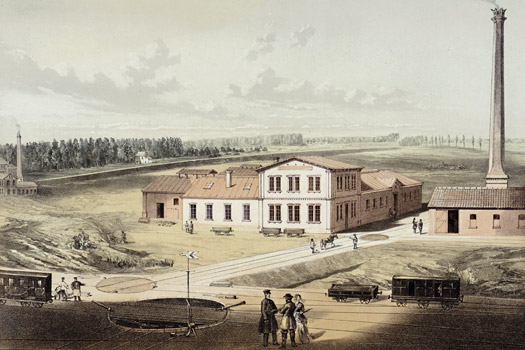
Von der Vieille Montagne zur Zink Altenberg
Steinkohle und Eisenbahnstation, vor allem aber der zollfreie Absatz auf dem wachsenden deutschen Markt zogen belgisches Kapital 1854/55 nach Oberhausen.
© LVR-Industriemuseum, Oberhausen
Kapital zurück zur Auswahl
The Altenberg zinc factory in Oberhausen
From the Belgian Vieille Montagne to the German Altenberg
The lithograph from 1856 depicts the first plants belonging to what is later known as the “Zink Altenberg”. In 1855 the factory came into operation as a zinc mill belonging to the Belgian company “Société anonyme des Mines et Fonderies de Zinc de la Vieille Montagne”. Translated, the name of the company from Liège is “Aktiengesellschaft für Bergbau und Zinkhütten vom Alten Berg“ (“Public company for Mining and Zinc Smelting Works from the old mountain”). Not until 1934, during the time of National Socialism, was the French name germanised and, from then on, read “Zink Altenberg”.
Why did a Belgian company move to what is today known as the Ruhr area in the 1850s? The tariff union united the German States into one economic zone in 1834, and imposed tariff barriers to resist imports. This market grew and Oberhausen offered companies like “Vieille Montagne” not only the bituminous coal needed for production, but also a station along the Cologne-Mindener railway. Opened in 1847 this railway quickly became a main artery in the Ruhr industry. Because the Liège company located itself and produced things locally it was able to profit from the market potential and to avoid the import tax as a “local” company.
The “Vieille Montagne” expanded its Oberhausen mill by one facility in 1856/57, which was used for the calcination of the zinc blend (ZnS). Until 1928, this raw material was freed of sulphur in the calcination furnace for the manufacture of zinc: in 1884, these low fireplaces already contaminated the surrounding area with eleven tons of gaseous sulphur daily, as established in a report from this year. Even worse were the stressors placed on the workers by heavy metals in the calcination and smelting furnaces. Slowly poisoned, most of them were invalids around 1900, at age 45 only. Here, in the middle of the city, it was above all the environmental issues that led to its decommissioning in 1981. Parts of the zinc factory were transformed into a cultural center. Since 1985, Altenberg is also the center and showplace of the LVR Industry Museum with a display featuring the history of the heavy manufacturing industry.
Denkmale zum Impuls
Oberhausen - Zink Altenberg
Nur noch wenige Ensembles aus Fabrik, Unternehmervilla und Arbeitersiedlung zeugen im Ruhrgebiet ... weiter

